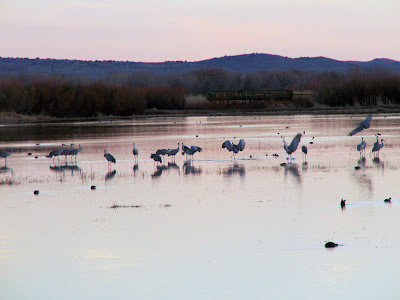
The things a writer won’t do for research. On Friday, I headed into the Chihuahuan Desert to explore it as a possible setting for my next novel. How about following some of those unpaved roads off I-25 and heading in the direction of the San Andres Mountains? What a great idea! Maps show a road leading to a locked gate at the edge of the White Sands Missile Range, which encompasses the entire hundred-plus-mile mountain range. Nothing appears to be paved between the Interstate and the restricted federal land. There are very few roads, and they are marked poorly when they are marked at all. Creosote bushes, grassy clumps, prickly pear, cholla, and other low-growing vegetation dominate the landscape. Rattlesnakes aren’t obvious, but travelers on foot had better tread with care.

What have I forgotten? Oh yes, sand. The county road is like a washboard for the first mile or two, and you can drive on it in perfect safety if not in perfect comfort. Hard-packed sand and a wide road pose no problem.
Long-neglected fencing drew my attention, though out here it’s hard to know what is being kept in or being kept out. At a fork in the road, a tiny sign points towards Engle, a town that is nowhere in sight across a vast, open space. On the other branch is the back of a yield sign that's peppered with bullet holes. I followed that left and never saw another sign until I returned on foot—about which more later. That looked like the direction to follow, as it would take me deeper into Sierra County, where Spaceport America is going to be built some day soon.
The road split again, and my sharp left turn gave me serious pause. I stepped out of my car to check the road ahead, because it looked as though I might be about to drive off a cliff. If you’ve driven the dicier hills in San Francisco, that’s what it looked like. But okay. Reassured that my death was not imminent, I drove carefully down the hill.
From here on, the road narrows to barely more than a car’s width. Deep gullies appear in several places along the roadside. The sand becomes softer—much softer. At another fork, I took a right and saw the road parallelling a string of telephone poles that seemed to disappear into endless flat nothing. That looked like a mistake, so I executed a careful three-point turn (four-point, really). The banks of sand on either side proved no problem.

Back at the fork, I took a right—not my first mistake of the day, but surely my biggest. My all-wheel-drive Volvo got stuck in a deep sand bank. What a mess. I had nothing to work with but my hands. All four wheels were stuck, and I couldn't see any daylight between the sand and the undercarriage.
I looked around: not a building in sight, and absolutely no traffic. I started digging with my hands and jamming flat rocks under the tires for traction. No go. I called my wife and then AAA. The lady asked how many feet my car was off the paved road. About 15,000, I said, estimating three miles from the highway. Triple-A really wasn’t a viable option, as any tow truck would likely have gotten stuck itself.
Eventually, after more hand-digging, I abandoned the car and hiked back to the highway. One fellow in a pickup truck stopped on the way, but said it would be a couple of hours before he could help me, as he had to go help his mother, who was recovering from a stroke. He offered me a ride, but he was going in the wrong direction, and it was getting dark. So I thanked him and kept walking to the highway, with the plan of making it to the Border Patrol checkpoint a few miles to the south. Within a few minutes, a Border Patrol cruiser picked me up and gave me a lift to their station. My wife arranged for some friends to come and pick me up.
The next day, my friend and our wives drove back, bringing shovels and cardboard for traction. We went down that steep hill, immediately thought better of it, and turned around in what was the last available wide spot. Then we hiked about a mile, pretty much all on a downhill slope.
Even with two shovels and four brains, it took us 90 minutes to extract the car, but we did succeed. Then we all headed north to the Bosque del Apache National Wildlife Refuge, where we rounded out an oddly satisfying day.

There is a lesson in this, that we must respect the desert. It’s still winter, and the 60-degree day turned into a 30-degree night. In the blazing summer heat, my gaffe could have been deadly.


















2 comments:
I'm finally getting a chance to read about something other than the desert of Arabia, so I now get a chance to read about the desert of New Mexico.
I'm very glad you survived--that getting stuck and walking out business sounds dangerous as well as laborious. Please be more careful--the IRB needs you!
Carter
Give me New Mexico's desert over the Sahara any day. At least there's an interstate somewhere!
Post a Comment